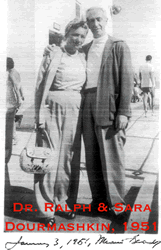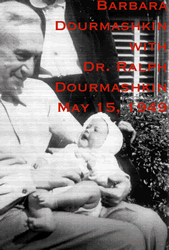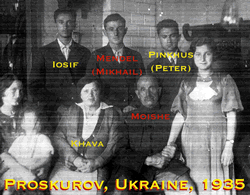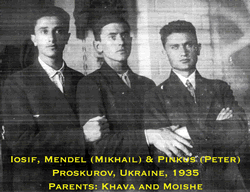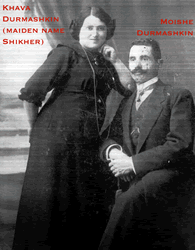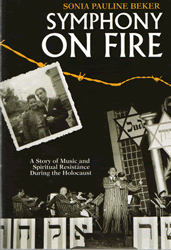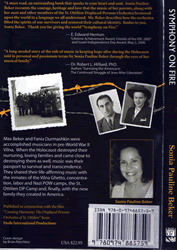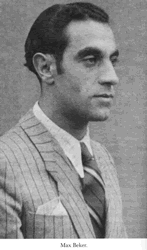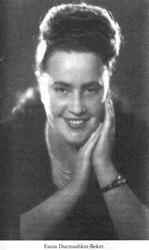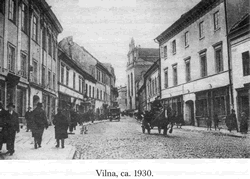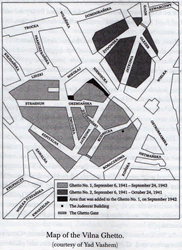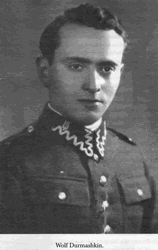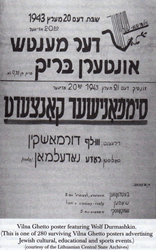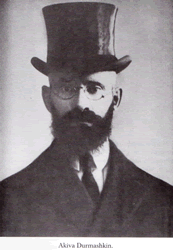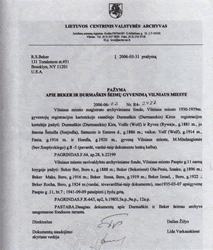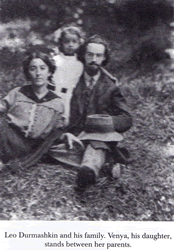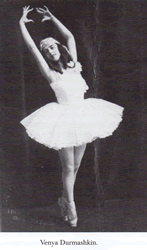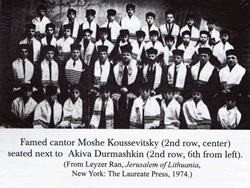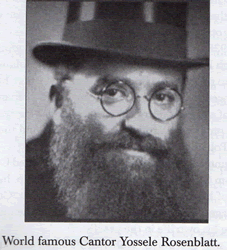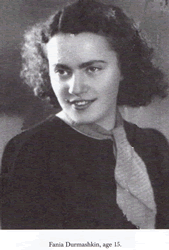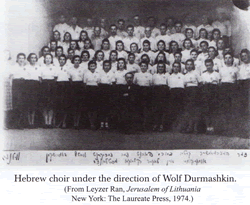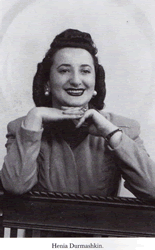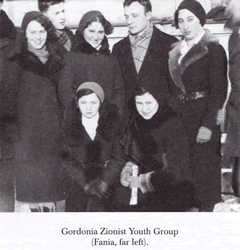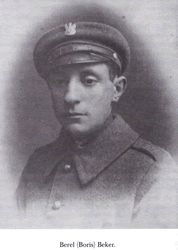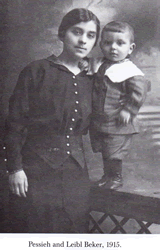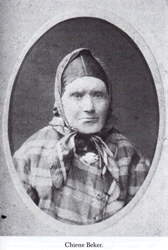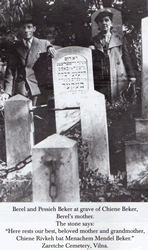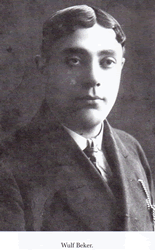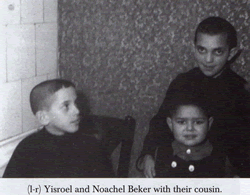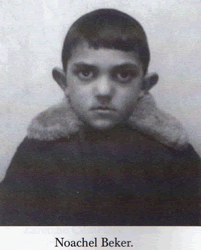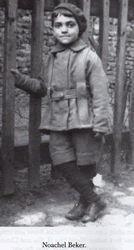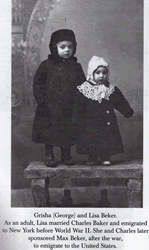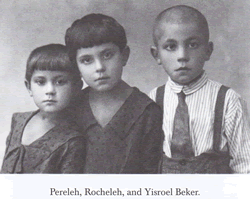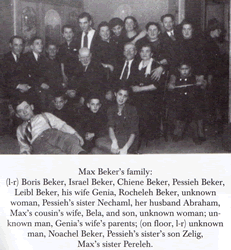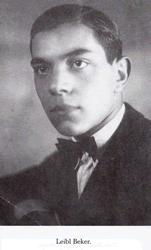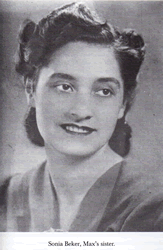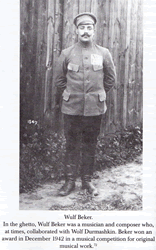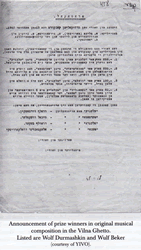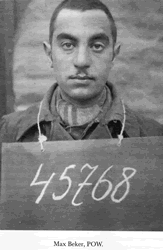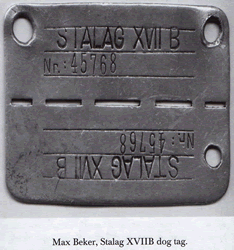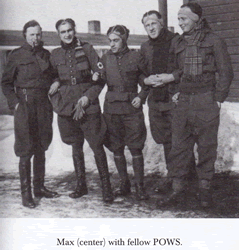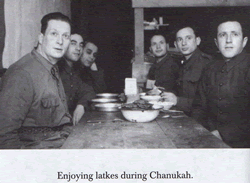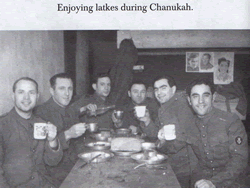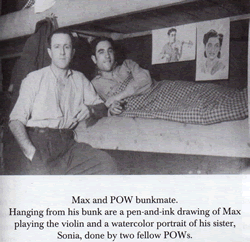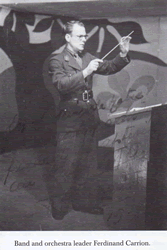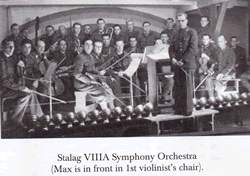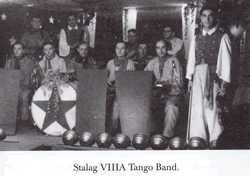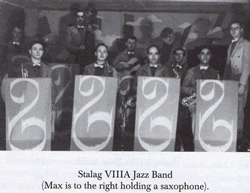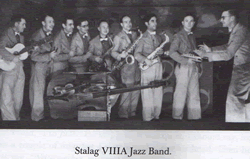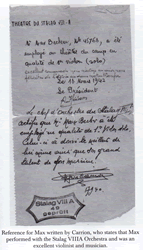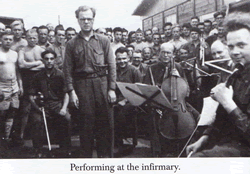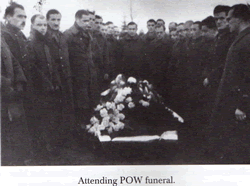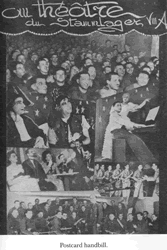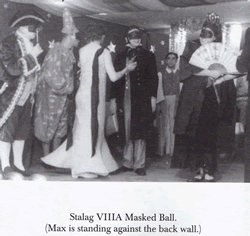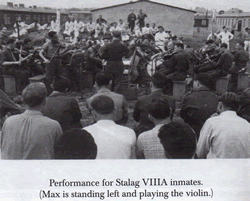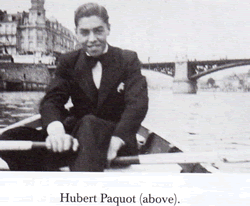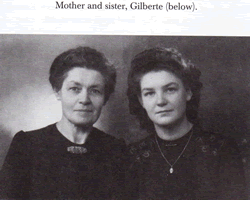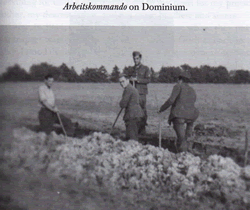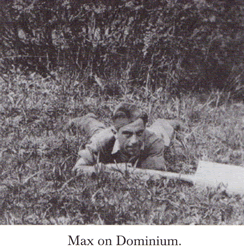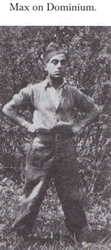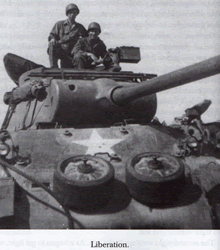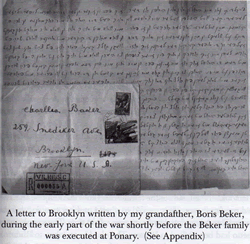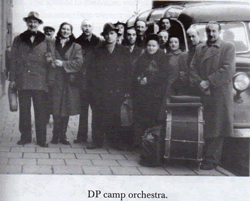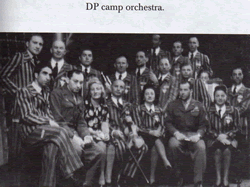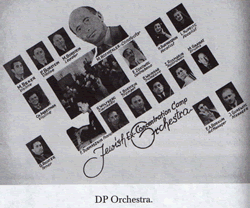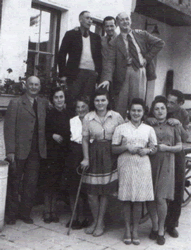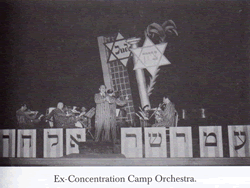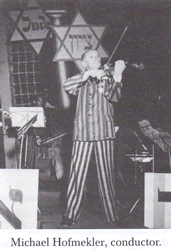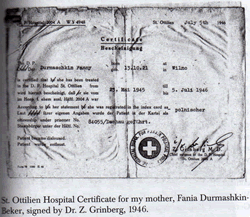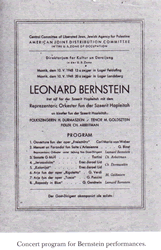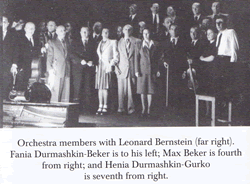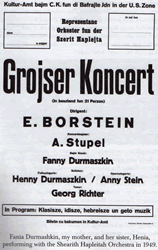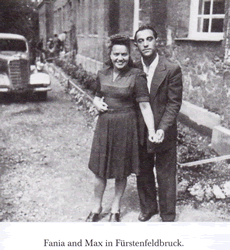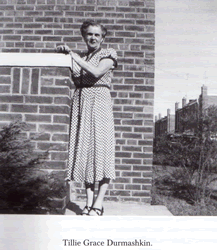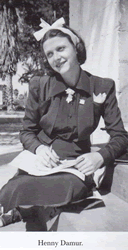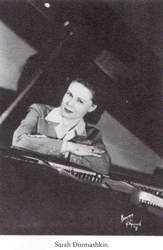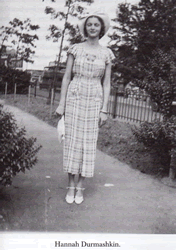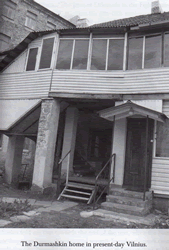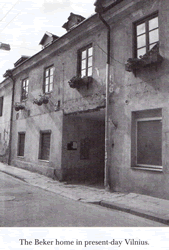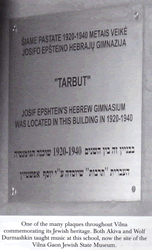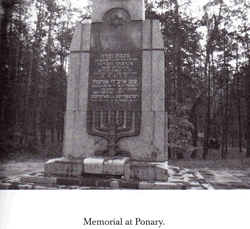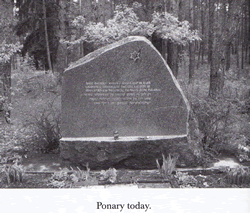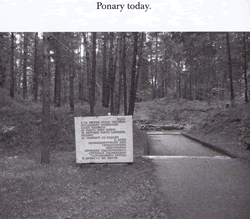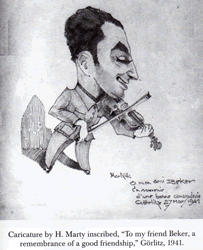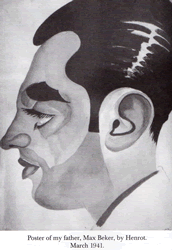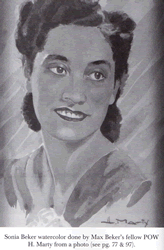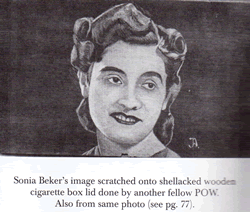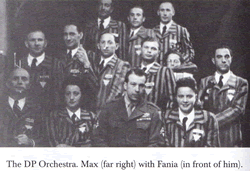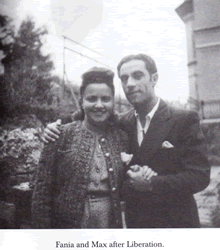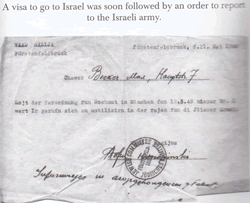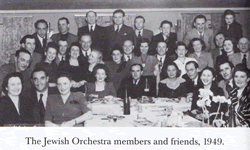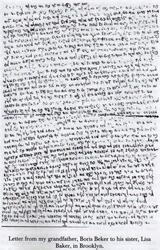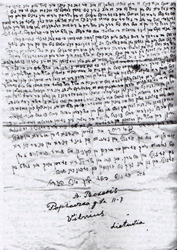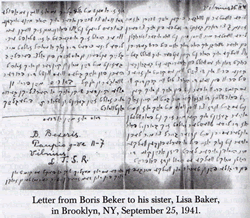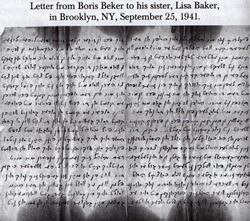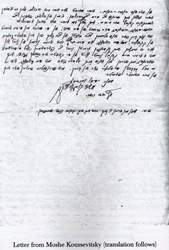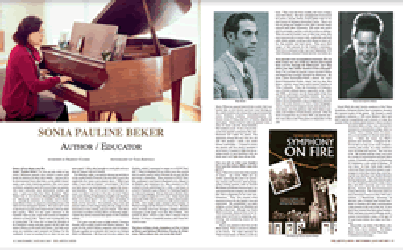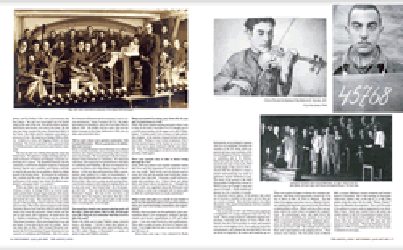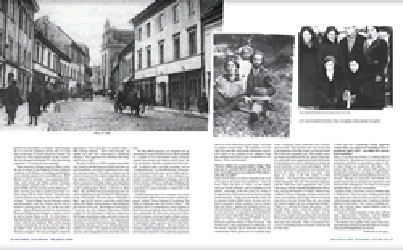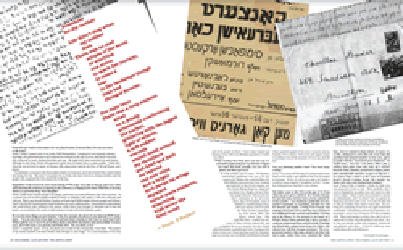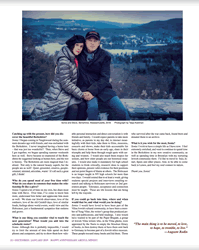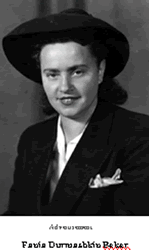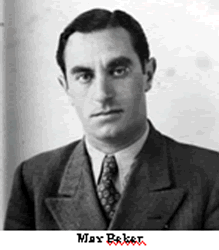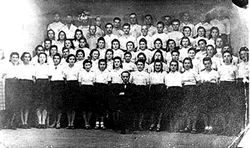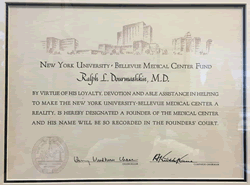#dmkn-6
#dmkn-7
Wolf Dormashkin, conductor of the Philharmonic Orchestra in Vilnius .
: typo3.ort.org/index.php?id=142
Wolf Durmashkin.
Among the many Jewish artists, musicians and writers of pre-war Vilna, the pianist and conductor Wolf Durmashkin stood out. Born in 1914, by the age of seven he had already started giving public piano recitals. He graduated from the Vilna conservatory of music at the age of 23, and moved briefly to Warsaw to continue his musical training. When war broke out in 1939, Durmashkin decided to return to his home city, where he initially found employment as a conductor and music teacher.
Soon after the Nazis entered Vilna in 1941, he and the tens of thousands of Jews not immediately murdered by the Nazis or their Lithuanian auxiliaries were forced into the cramped confines of the ghetto. There, Durmashkin continued his musical work, composing, organising an orchestra, and helping to create a music school that enrolled over a hundred students. He was also the founder and director of a Hebrew ghetto choir.
The musical world created in Vilna through the commitment of young musicians like Durmashkin was to come to an abrupt and bloody end. In January 1943, a year after the first theatre concert commemorating the mass murders at Ponar, the ghetto soprano Lyube Levitski was rehearsing her role for an upcoming opera, under Durmashkin's direction. Levitski was caught smuggling food into the ghetto for her sick mother, and was arrested and subsequently killed. Shortly thereafter, Durmashkin was deported to the Klooga concentration camp in Estonia during the liquidation of the ghetto. Tragically, he was killed one day before liberation.
Sources
Kalisch, Shoshana. (1985). Yes, We Sang! Songs of the Ghettos and Concentration Camps. New York, Harper.
USHMM Photo Archive (biographical information
#dmkn-200
Akiwa A conductor,
composer and a cantor Holocaust (Wilna) Radom / Wilna page 265 of a
book about well known Jewish Musicians
His son; DURMASZKIN Wolf A pianist, accompanist and a conductor
1914-1944 Holocaust (killed in Astonia) lived in Wilna page 263 of a
book about well known Jewish Musicians
From Yad Vashem;
Durmaszkin Akiva
Akiva Durmaszkin was born in Mogilev, Belorussia. He was a composer
and married to Sheine. Prior to WWII he lived in Wilno, Poland. During
the war was in Wilno, Poland. Akiva died in Ponary, Poland at the age
of 56. This information is based on a Page of Testimony submitted by
his daughter ( Fanny Beker of Brooklyn there is an address) from United
states
Durmaszkin Sheine
Sheine Durmaszkin was born in Mogilev, Belorussia. She was a
housewife and married to Akiva. Prior to WWII she lived in Wilno,
Poland. During the war was in Wilno, Poland. Sheine died in 1943 in
Ponary, Poland at the age of 53. This information is based on a Page
of Testimony submitted by her daughter ( Fanny Beker of Brooklyn) from
United states
Durmaszkin Wolf
Wolf Durmaszkin was born in Wilno, Poland to Akiva and Sheine in
1912. He was a composer. Prior to WWII he lived in Wilno, Poland.
During the war was in Wilno, Poland. Wolf died in the Shoah at the age
of 31. This information is based on a Page of Testimony submitted by
his sister( Fanny Beker of Brooklyn) from United states
Durmaszkin Leonard
The next person is likely the brother of Akiva since he is the son of
Wolf , and Akivas' son is named Wolf, most likely for his grandfather-
you could see how little his children knew of his ancestry;
His son gave report with Vilna as his birth place and Miryam as his
mother.;
Leonard Durmaszkin was born in Wilno, Poland in 1884 to Wolf and
Myriam. He was a painter and married to Hanna. Prior to WWII he lived
in Paris, France. During the war was in Paris, France. Leonard died in
1942 in Auschwitz at the age of 58. This information is based on a
Page of Testimony submitted on 17/09/2000 by his son Georges
Durmaszkin in Paris, ( there is an address) a Shoah survivor
His daughter gave report with Minsk as his birth place and Sarah for
his mother;
Durmaszkin Leonard
Leonard Durmaszkin was born in Minsk, Belorussia in 1887 to Wolf and
Sarah. He was a painter (artist) and married to Channa. Prior to WWII
he lived in Paris, France. During the war was in Paris, France.
Leonard died in Auschwitz. This information is based on a Page of
Testimony submitted by his daughter from Australia ( There is an
address)
Durmashkin Khava
Khava Durmashkin was born in 1882. She was married to Moishe. Prior
to WWII she lived in Khmelnitskiy, Ukraine. During the war was in
Khmelnitskiy, Ukraine. Khava died in 1941 in Khmelnitskiy, Ukraine at
the age of 59. This information is based on a Page of Testimony
submitted by her niece from Ukraine. More Details...
Durmashkin Moishe
Moishe Durmashkin was born in 1886. He was married to Khava. Prior
to WWII he lived in Khmelnitskiy, Ukraine. During the war was in
Khmelnitskiy, Ukraine. Moishe died in 1941 in Khmelnitskiy, Ukraine at
the age of 55. This information is based on a Page of Testimony
submitted by his nephew from Ukraine. More Details...
Submitter's Last Name TAIKH
Submitter's First Name M
( there is an address in Russian)
Look up artist Durmashkin, Henny
--------------------------------------------------------------------------------
Name: Henny Durmashkin/ Gurko, . She was the daughter of Akiva
Durmashkin and sister to Wolf and fanny Beker
Name (Yiddish): דור×?×?ַשקין, ×”×›× ×™
Also known as: Gurko, Henny Durmashkin
Born: 1924 (Vilna)
Died: 2002 (USA)
--------------------------------------------------------------------------------
Tracks with this artist
--------------------------------------------------------------------------------
Title: Alu L'erets Avot -- עלו ל×?רץ ×?בות
Also known as: Alu Alu
Genre: Israeli/Zionist
Subject: Land/Fathers/Pioneer
Origin: Alb N-014(a)/
Transliteration: Alb L-009(a)/Alb N-014(a)
Translation: Alb N-014(a)
Music: Nath 92
On album: D-007(a) (Songs To Remember Henny Durmashkin -- לידער
צו
×’×¢×“×¢× ×§×¢×Ÿ! ×–×¢× ×’×¢×¨×™×Ÿ ×”×¢× ×™ דור×?×?ַשקין )
Artist Durmashkin, Henny -- דור×?×?ַשקין, ×”×›× ×™
Artist Durmashkin, Fanny, piano acc -- דור×?×?ַשקין,
פֿ×?Ö·× ×™, ×¤Ö¼×™×¢× ×?Ö¸ ב×?Ö¸×’×œ×²Ö·×˜×•× ×’
First line: Alu, alu, l'erets avot, l'artsenu alu beshir uvimkholot,
First line (Hebrew):עלוּ, עלוּ, ל×?רץ ×?בות, ל×?×¨×¦× ×•
עלוּ בּש×?יר
וב×?חולות, תורה ×?×?ת...
Language: Hebrew
Style: Hora
IN MEMORY OF A CELEBRATED
COMPOSER AND CONDUCTOR
A concert entitled "Lider fun Vilner geto" was dedicated to the memory
of wonderful musician and conductor Volf (Zeev) Durmashkin, a graduate
of the Vilnius and Warsaw conservatoires, and the unique organizer and
conductor of the Vilna Ghetto symphony orchestra. The event, initiated
by known Lithuanian journalist Pranas Morkus, whose family helped Jews
during the war period, took place in the "Leli¸" Theatre, where the
Ghetto orchestra had performed in 1942-1943.
The talented conductor's star rose just prior to the onset of the war,
which brutally severed his path to artistic greatness: V.Durmashkin
perished at the age of 30, on Sept. 19, 1944, in the Klooga
concentration camp.
During its 15 months in existence, the Ghetto orchestra performed 35
chamber and sym-phonic concerts. The last one took place on Aug. 29,
1943, three and a half weeks before the Ghetto was liquidated.
The memorial concert was presented by the Vilnius St. Christopher
Chamber Orchestra, led by known Lithuanian musician Donatas Katkus.
Songs of the Vilna Ghetto, arranged for the Orchestra by composer
J.Cechanovich, were performed by Maria Krupoves, who is known for her
pure Yiddish articulation, genuine musical talent, and gentle and
unassuming manner of singing
Sonia Pauline Beker
Thank you for offering to post the profile and photo of my mom, Fania Durmashkin-Beker, which I sent you in a separate email. Here's a recent interview I had with The Artful Mind magazine. Its content and photos are all about my family and Jewish cultural Vilna before the War. Hope you can post it on your Durmashkin family web page!! Please let me know!!
Thank you very much!!
Best,
Sonia.
https://issuu.com/theartfulmindartzine/docs/the_artful_mind_dec_jan_2019_annive/16
My name is Barbara Dourmashkin. My grandfather: Dr. Ralph Dourmahkin,
came to America from Minsk or a village close to Minsk (I believe) in
1906.
Ellis Island records for Ralph / Refol, his mother Rachel/ Rose, his
sister ; Liza and his sister ; Sonia;
Manifest for Deutschland
Sailing from Hamburg
Date of Arrival: April 26, 1906;
Name Gender Age Married Ethnicity Place of Residence
0005. Durmaszkein, Rachel F 43y M Russia Hebrew Minsk
0006. Durmaszkein, Refol M 15y S Russia Hebrew Minsk
0007. Durmaszkein, Liza F 6y S Russia Hebrew Minsk
0008. Durmaszkein, Sonia F 9y S Russia Hebrew Minsk
All going to their brother in New York
Census of 1910;
Name: Rachael F Dourmaskin Age in 1910: 47 Estimated birth year: abt
1863 Home in 1910: 10-Wd Manhattan, New York, New York she works with
Dresses? in Woolworth?
living with son Raphael; age 18, is a cutter in a shop, son Victor;
age 16 salesman, daughter Leja; age 19 seamstress and daughter; Sophia
age 14.They all came to the country in 1906- none are Naturalized yet.
Census of 1920; Ralph L Dourmashkin Age: 25 years Estimated birth
year: abt 1895 Birthplace: Russia Race: White Home in 1920: Manhattan,
New York, New York
came to the country in 1906 naturalized in 1916. Medical doctor in
General practice.
Wife; Sara was born in New York c 1899 to Russian parents. She is a
bacteriologist in the health department.
Rachel Dourmashkin (Mother of Ralph) is named Rose in the 1920s census;
Name: Rose Dourmashkin Age: 53 years Estimated birth year: about 1867
Birthplace: Ch--? Russia Race: White Home in 1920: Manhattan, New
York, New York Home rented she is a widow. Son; Victor who is 26 lives
with her. Victor as his mother, came to the country in 1906 ( he came
from Minsk, Russia) but only he was Naturalized in 1916, not his
mother, his sister Sophy ( Sonia?) age 22 also came to the country in
1906 or his niece; Vera 9. Victor is a salesman in Ago? Store. The
Granddaughter Vera came to the country in 1912 ( really January of
1913) from Moscow, Russia. She is 9 years old and her parents are from
Minsk. They live on East Twelfth Street, Manhattan.
Brother of Ralph in Ellis Island; First Name: Elias Last Name:
Durmaschkin Ethnicity: Russia, Hebrew Last Place of Residence: Moscow,
Russia Date of Arrival: January 27, 1913 Age at Arrival: 28y Gender: M
Marital Status: W Ship of Travel: Pennsylvania Port of Departure:
Hamburg Manifest Line Number: 0014
Elias is 5' 7" with Black hair and Brown eyes. He is going to his
mother; Rachel Durmaschkin 546 104th Street, New York with him is his
baby daughter;
First Name: Vera Last Name: Durmaschkin Ethnicity: Russia, Hebrew Last
Place of Residence: Moscow, Russia Date of Arrival: January 27, 1913
Age at Arrival: 11m Gender: F Marital Status: S Ship of Travel:
Pennsylvania Port of Departure: Hamburg Manifest Line Number: 0015
In the 1930 census we find; Name: Victor L Dourmashkin Age: 34
Estimated birth year: abt 1896 Birthplace: Minsk, Russia Relation to
head-of-house: Head Spouse's Name: Pauline Dourmashkin who is 25 years
old and was born in New York. Victor married her at age 31 she was 22.
Her parents were from Poland. Race: White Home in 1930: Bronx, Bronx,
New York. There place on 55 West 180th street Ap. 615 is rented for
$50. Victor is a Radio salesman.
They have a son; Paul M. who is one years and eight months old and
was born in New York.
1930 census;
Ralph Dowrmashkin ( I read it "Dourmashkin")Birth: abt 1892 - Russia
Residence: 1930 - Manhattan, New York, New York
Source: Census - 1930 United States Federal Census
242 E. 19th rent $ 187.50 he is a physician who owns an office.
wife;
Sarah Dowrmashkin Birth: abt 1899
Residence: 1930 - Manhattan, New York, New York
Source: Census - 1930 United States Federal Census
son; Lenard Dowrmashkin Birth: abt 1922
Residence: 1930 - Manhattan, New York, New York
Source: Census - 1930 United States Federal Census
son; Robert Dowrmashkin Birth: abt 1926
Residence: 1930 - Manhattan, New York, New York
Source: Census - 1930 United States Federal Census
they had a maid; Chuba Catherin from Austria- she was age 19 and came
to the country in 1927
-----------------------
Pauline Dowrmashkin Other: Unknown Date
Source: Immigration - New York Petitions for Naturalization
Sara Dourmashkin was born; 26 Jun 1898 she died; Mar 1985 New York,
New York, New York New York (1958-1959 ) 128-32-2239 V
Name Birth Date Death Date Last Residence (City,County,State) Issued
SSN
Leonard Dourmashkin was born 12 Aug 1921 he died;1 Aug 1994 Ardsley,
Westchester, New York Vermont (Before 1951 ) 008-16-5197
First Name: Selena Last Name: Durmaschkin Ethnicity: Russia, Hebrew
Last Place of Residence: Mogilow Date of Arrival: February 17, 1904
Age at Arrival: 25y Gender: F Marital Status: S Ship of Travel:
Statendam Port of Departure: Rotterdam Manifest Line Number: 0016
Selena is a dressmaker, going to cousin Jacob Bricker in New York
First Name: Schloma
Last Name: Durmaschkin
Ethnicity: Hebrew
Last Place of Residence: Ciszowka, Russia
Date of Arrival: December 22, 1913
Age at Arrival: 22y Gender: M Marital Status: S going to an uncle in
Union Hills
Ship of Travel: George Washington
Port of Departure: Bremen
Manifest Line Number: 0021
August 08, 1907 Bremen - 
Manifest for Barbarossa
Sailing from Bremen;
0023. Durmskin, Henie F 33y W Russia Mogilew, Russia
0024. Durmskin, Dine F 14y S Russia Mogilew, Russia
0025. Durmskin, Hilel M 10y S Russia Mogilew, Russia
0026. Durmskin, Mottel M 2y 6m S Russia Mogilew, Russia
First Name: Maria
Last Name: Durmasskin
Ethnicity: Russian, Hebrew
Last Place of Residence: Mohiluos
Date of Arrival: December 08, 1903
Age at Arrival: 20y Gender: F Marital Status: S going to relative in
Chicago
Ship of Travel: Kaiser Wilhelm II
Port of Departure: Bremen
Manifest Line Number: 0001
Name Birth Date Death Date Last Residence (City,County,State) Issued
SSN
Leonard Dourmashkin was born 12 Aug 1921 he died;1 Aug 1994 Ardsley,
Westchester, New York Vermont (Before 1951 ) 008-16-5197
Sara Dourmashkin was born; 26 Jun 1898 she died; Mar 1985 New York,
New York, New York New York (1958-1959 ) 128-32-2239 V
Name: Dourmashkin, Ralph Leo Birth - 1891- Accession Number: 1124886
Source Citation: Encyclopedia of American Biography. New Series.
Volume 11. New York: The American Historical Society. Use the Index to
locate biographies.(EncAB-A 11) Biography contains portrait. Who Was
Who among North American Authors, 1921-1939. Compiled from [Who's Who
among North American Authors,] Volumes 1-7, 1921-1939. Two volumes.
Gale Composite Biographical Dictionary Series, Number 1. Detroit: Gale
Research, 1976.(WhNAA)
Name: Dourmashkin, Ralph Leo Birth - : 1891-Death 1956 Accession
Number: 1124887 Source Citation: Biography Index. A cumulative index
to biographical material in books and magazines. Volume 4: September,
1955-August, 1958. New York: H.W. Wilson Co., 1960.(BioIn 4)
Name: Dourmashkin, Robert Ralph Birth- : 1925- Accession Number:
1124888 Source Citation: International Medical Who's Who. A
biographical guide in medical research. First edition. Two volumes.
Harlow, United Kingdom: Longman Group, 1980.(IntMed) Name Declaration
Volume Declaration Page Petition Volume Petition Page Index to
Declaration of Intent for Naturalization: New York County, 1907-1924 ;
Raphael Dourmashkin 28 224
Elias Dourmashkin 263 328
Sophie Dourmashkin 470 73
Vera Dourmashkin Rubin
1911 - 1985
Born in Moscow in 1911, Vera Dourmashkin Rubin is most remembered as
founder of the Research Institute for the Study of Man, and for her
studies of the West Indies. She came to the United States with her
father when she was an infant, having lost her mother in childbirth.
Vera "…grew up in an intellectual atmosphere in the Jewish immigrant
community of New York's Lower East Side" (Saunders 1985: 316). She
graduated summa cum laude from "http://www.nyu.edu/" (NYU) in 1930.
After raising two children, Vera re-entered academia. Intending to
become a psychiatrist, she decided first to take some anthropology
courses prior to entering medical school. "Anthropology seized her
imagination" (Saunders 1985:316) and she ended up enrolling at
"http://www.columbia.edu/", studying with
"http://www.cas.usf.edu/anthropology/women/ruthb/ruthbenedict.htm" and
"http://www.cas.usf.edu/anthropology/women/mead/margaret_mead.htm".
Her major advisor and primary intellectual influence was
"http://www.anthro.mankato.msus.edu/bio/Steward.htm". Vera earned her
doctorate from Columbia in 1952.
The Flag of Haiti (theodora.com)
Her first postdoctoral position (unpaid) involved research on Irish
Americans and focused on the intersections of mental health,
ethnicity, and urban life. Her lifetime interest, though, was in the
English-speaking Caribbean and in 1955, Vera founded the
"http://www.rism.org". The Institute served as a scholarly focal point
for the then nascent "http://lanic.utexas.edu/las.html" as well as
providing training and funding for students, particularly women, to
work in Latin America. Vera would serve as the Institute's director
for thirty years.
In 1969, Vera wrote We Wish to Be Looked Upon, a study of student
aspirations in "http://www.trinidad-online.org/". She later edited the
volume proceedings of a symposium on
"http://www.hist.unt.edu/09w-blk4.htm" sponsored by the
"http://www.aaas.org/". This volume was part of a series of monographs
of the "http://www.ameranthassn.org/aes.htm"
Map of Haiti and Jamaica
Vera organized several highly successful and influential conferences
on Caribbean studies. She was on the faculty of the Columbia
University Joint Program in
"http://www.acs.oakland.edu/~dow/anthap.html" at
"http://www.tc.columbia.edu/" and during her career taught at NYU,
"http://www.brandeis.edu/", and "http://www.nymc.edu/". Vera assisted
"http://www.peacecorps.gov/" volunteers in the Caribbean and was
instrumental in facilitating a collaborative research project on aging
Today we celebrate Vera Dourmashkin Rubin, a pioneering woman
professional who was dedicated to multidisciplinary research, to
advancing studies of the English-speaking Caribbean, and to supporting
graduate student field research.
< "http://www.cas.usf.edu/anthropology/women/index.html" >
I bequeath to my family and my friends my love of life. May they
spread pacem in terris and pacem in maribus. I urge all to lead a
creative life (Anthropology Newsletter 1985:4).
Selected Works By Vera
1960 Caribbean Studies: A Symposium. Seattle: University of Washington.
1960 Culture, Society and Health. New York: New York Academy of
Sciences.
1969 We Wish To Be Looked Upon: A Study of the Aspirations of Youth in
a Developing Society. New York: Teachers College Press. [with Marisa
Zavalloni].
1975 The Haitian Potential: Research and Resources of Haiti. New York:
Teachers College Press. [with Richard P. Schaedel].
1976 Ganja in Jamaica: The Effects of Marijuana Use. Garden City, NY:
Anchor. [with Lambros Comitas
Barbara also wrote;
I live with my husband, an architect, and I have two daughters; one in
high school and another at UC Berkeley. I live in Sherman Oaks,
California. I am a Disney animator. . My father Leonard was a Doctor
and two of my brothers are doctors, Michael Dourmashkin from Locust
Valley, New York married to Louise ( children Mark, Steven, and Lisa)
and Thomas from North Hampton, MA ( Jordan, Caitlin and Susannah)
married to Cindy and my brother Peter is a professor at MIT married to
Dorothy, (children Camille and Clairissa). My father's brother Robert
is also a doctor married to an actress Cindy and lives in England. I
have a living relative in Moscow, but the rest of our branch of the
family lives in the USA, mostly in the East Coast. Eilat Levitan is a
friend of mine, and she is the one who created the wonderful site
which allows us to research family members.
Other found on Ancestry.com;
Marc Durmashkin is a vocal Music teacher. Age: 47 years (Estimated
birth year): abt 1873 Birthplace: Mogilov, Russia Race: White Home in
1920: Seattle, King, Washington Home owned: "" Marital status: "
Year of immigration:1917 with his entire family.
Wife who is 31 years old, and born in Odessa. Daughters Sara age 7
born in Odessa, Hene age 6 born in Odessa and Anna age 5 born in
Odessa Roll: T625_1929 Page: 1A ED: 265 Image: 0699
Name: Tillie Durmashkin SSN: 087-12-5480 Last Residence: 10471 Bronx,
Bronx, New York, United States of America Born: 7 Apr 1891 Died: Dec
1974 State (Year) SSN issued: New York (Before 1951 )
Index
Fanny Durmaskin Other: Unknown Date
Source: Immigration - New York Petitions for Naturalization
Sam Durmaskin
Source: Immigration - Index to Declaration of Intent for
Naturalization: New York County, 1907-1924
Sam Durmaskin Other: 15 Mar 1924
Source: Immigration - New York County Supreme Court Naturalization
Petition Index, 1907-24
HARRIET DURMASKIN
LEONARD Residence: 33437-4175, BOYNTON BEACH, FL
Source: Directories - 2000 Phone and Address Directory
HARRIET DURMASKIN Residence: 08902-1805, NORTH BRUNSWICK, NJ
Source: Directories - 2000 Phone and Address Directory
JAY DURMASKIN
JULIE Residence: 68154-2939, OMAHA, NE
Source: Directories - 2000 Phone and Address Directory
LEONARD DURMASKIN Residence: 08902-1805, NORTH BRUNSWICK, NJ
Source: Directories - 2000 Phone and Address Directory
NORMAN DURMASKIN
GLORIA Residence: 33437-6408, BOYNTON BEACH, FL
Source: Directories - 2000 Phone and Address Directory
S DURMASKIN Residence: 67226-1140, WICHITA, KS
Source: Directories - 2000 Phone and Address Directory
S C DURMASKIN Residence: 02453-2509, WALTHAM, MA
Source: Directories - 2000 Phone and Address Directory
S M DURMASKIN Residence: 67226-1140, WICHITA, KS
Source: Directories - 2000 Phone and Address Directory
BRIAN DURMASKIN Residence: 1993 - 68108, OMAHA, NE
Source: Directories - 1994 Phone and Address Directory
JAY DURMASKIN Residence: 1993 - 68154, OMAHA, NE
Source: Directories - 1994 Phone and Address Directory
LEONARD DURMASKIN Residence: 1993 - 08902, NEW BRUNSWICK, NJ
Source: Directories - 1994 Phone and Address Directory
NORMAN DURMASKIN Residence: 1993 - 33351, FT LAUDERDALE, FL
Source: Directories - 1994 Phone and Address Directory
S C DURMASKIN Residence: 1993 - 02154, WALTHAM, MA
Source: Directories - 1994 Phone and Address Directory
S M DURMASKIN Residence: 1993 - 67226, WICHITA, KS
Source: Directories - 1994 Phone and Address Directory
Durmaskin Harriet Residence: 08902, North Brunswick, NJ
Source: Directories - 2002 Phone and Address Directory
Durmaskin Harriet & Leonard Residence: 33437, Boynton Beach, FL
Source: Directories - 2002 Phone and Address Directory
Durmaskin Harriet Residence: 33437, Boynton Beach, FL
Source: Directories - 2002 Phone and Address Directory
Durmaskin Jay & Julie Residence: 68154, Omaha, NE
Source: Directories - 2002 Phone and Address Directory
Durmaskin Leonard Residence: 08902, North Brunswick, NJ
Source: Directories - 2002 Phone and Address Directory
Durmaskin Norman & Gloria Residence: 33437, Boynton Beach, FL
Source: Directories - 2002 Phone and Address Directory
Durmaskin S C Residence: 02453, Waltham, MA
Source: Directories - 2002 Phone and Address Directory
Durmaskin S M Residence: 67226, Wichita, KS
Source: Directories - 2002 Phone and Address Directory

Marc Durmashkin is a vocal Music teacher. Age: 47 years (Estimated
birth year): abt 1873 Birthplace: Mogilov, Russia Race: White Home in
1920: Seattle, King, Washington Home owned: "" Marital status: "
Year of immigration:1917 with his entire family.
Wife who is 31 years old, and born in Odessa. Daughters Sara age 7
born in Odessa, Hene age 6 born in Odessa and Anna age 5 born in
Odessa Roll: T625_1929 Page: 1A ED: 265 Image: 0699
Name: Tillie Durmashkin SSN: 087-12-5480 Last Residence: 10471 Bronx,
Bronx, New York, United States of America Born: 7 Apr 1891 Died: Dec
1974 State (Year) SSN issued: New York (Before 1951 )
Index
"javascript:go151ef54()"
Residence: 92037, LA JOLLA, CA
Source: Directories - 2000 Phone and Address Directory
"javascript:go151ef55()"
Residence: 92101, SAN DIEGO, CA
Source: Directories - 2000 Phone and Address Directory
"javascript:go151ef56()"
Residence: 92101, SAN DIEGO, CA
Source: Directories - 2000 Phone and Address Directory
"javascript:go151ef57()"
Residence: 1993 - 92112, SAN DIEGO, CA
Source: Directories - 1994 Phone and Address Directory
"javascript:go151ef58()"
Residence: 92037, La Jolla, CA
Source: Directories - 2002 Phone and Address Directory
"javascript:go151ef59()"
Residence: 92101, San Diego, CA
Source: Directories - 2002 Phone and Address Directory
"javascript:go151ef510()"
Residence: 92101, San Diego, CA
Source: Directories - 2002 Phone and Address Directory
Fanny Durmaskin Other: Unknown Date
Source: Immigration - New York Petitions for Naturalization
Sam Durmaskin
Source: Immigration - Index to Declaration of Intent for
Naturalization: New York County, 1907-1924
Sam Durmaskin Other: 15 Mar 1924
Source: Immigration - New York County Supreme Court Naturalization
Petition Index, 1907-24
HARRIET DURMASKIN
LEONARD Residence: 33437-4175, BOYNTON BEACH, FL
Source: Directories - 2000 Phone and Address Directory
HARRIET DURMASKIN Residence: 08902-1805, NORTH BRUNSWICK, NJ
Source: Directories - 2000 Phone and Address Directory
JAY DURMASKIN
JULIE Residence: 68154-2939, OMAHA, NE
Source: Directories - 2000 Phone and Address Directory
LEONARD DURMASKIN Residence: 08902-1805, NORTH BRUNSWICK, NJ
Source: Directories - 2000 Phone and Address Directory
NORMAN DURMASKIN
GLORIA Residence: 33437-6408, BOYNTON BEACH, FL
Source: Directories - 2000 Phone and Address Directory
S DURMASKIN Residence: 67226-1140, WICHITA, KS
Source: Directories - 2000 Phone and Address Directory
S C DURMASKIN Residence: 02453-2509, WALTHAM, MA
Source: Directories - 2000 Phone and Address Directory
S M DURMASKIN Residence: 67226-1140, WICHITA, KS
Source: Directories - 2000 Phone and Address Directory
BRIAN DURMASKIN Residence: 1993 - 68108, OMAHA, NE
Source: Directories - 1994 Phone and Address Directory
JAY DURMASKIN Residence: 1993 - 68154, OMAHA, NE
Source: Directories - 1994 Phone and Address Directory
LEONARD DURMASKIN Residence: 1993 - 08902, NEW BRUNSWICK, NJ
Source: Directories - 1994 Phone and Address Directory
NORMAN DURMASKIN Residence: 1993 - 33351, FT LAUDERDALE, FL
Source: Directories - 1994 Phone and Address Directory
S C DURMASKIN Residence: 1993 - 02154, WALTHAM, MA
Source: Directories - 1994 Phone and Address Directory
S M DURMASKIN Residence: 1993 - 67226, WICHITA, KS
Source: Directories - 1994 Phone and Address Directory
Durmaskin Harriet Residence: 08902, North Brunswick, NJ
Source: Directories - 2002 Phone and Address Directory
Durmaskin Harriet & Leonard Residence: 33437, Boynton Beach, FL
Source: Directories - 2002 Phone and Address Directory
Durmaskin Harriet Residence: 33437, Boynton Beach, FL
Source: Directories - 2002 Phone and Address Directory
Durmaskin Jay & Julie Residence: 68154, Omaha, NE
Source: Directories - 2002 Phone and Address Directory
Durmaskin Leonard Residence: 08902, North Brunswick, NJ
Source: Directories - 2002 Phone and Address Directory
Durmaskin Norman & Gloria Residence: 33437, Boynton Beach, FL
Source: Directories - 2002 Phone and Address Directory
Durmaskin S C Residence: 02453, Waltham, MA
Source: Directories - 2002 Phone and Address Directory
Durmaskin S M Residence: 67226, Wichita, KS
Source: Directories - 2002 Phone and Address Directory
The Durmashkin-Beker- Gurko family
Max Beker
Sonia Beker is the daughter of Max Beker and Fania Durmashkin-Beker. Both of her parents grew up in musical families in Vilna. Fania was the daughter of Akiva and Sonia Durmashkin. Akiva was a cantor, teacher and composer. Fania had two siblings, Henia and Wolf. All three children received both Jewish and musical educations. Fania studied piano, and her sister Henia studied voice at the Vilna conservatory.
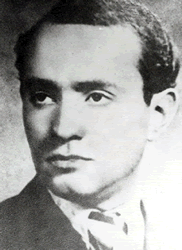
Wolf Durmashkin
Their brother Wolf was a child prodigy who began performing piano at young age. He studied composition, performance and conducting at both the Vilna and Warsaw Conservatories, and while still a young man, he became the conductor of the Vilna Symphony Orchestra. In September 1941 all the Jews in Vilna were forced to move to a ghetto. However, in response to a petition from the Vilna Orchestra, Wolf was allowed to leave the ghetto to continue as their conductor. One day the head of the ghetto, Jacob Gens summoned Wolf Durmashkin and asked him to create a ghetto orchestra to improve morale. Wolf also organized a 100 voice choir for which he wrote Hebrew songs. His conducted the first concert in the ghetto on March 15, 1942 in which his sister Fania performed the Chopin piano concerto. The orchestra's final concert was held on August 29, 1943, three and a half weeks before the ghetto was liquidated. In September, Germans held a selection choosing those capable for forced labor. All others, including Fania's parents, were taken to the Ponary forest and killed. Akiva was 56 years old, and Sheine only 53. Wolf was sent to Klooga, a work camp in Estonia. Shortly before the camp's liberation on September 19, 1944, German guards bound all the prisoners, shot them and burned their bodies. Wolf was 31 years-old. Fania and Henia were shipped to Kaiserwald, a camp on the outskirts of Riga Latvia, where they worked building cement canals. From there they were sent to Dinawerke, Stutthof, Dachau and Landsberg concentration camps. Fania was fortunate to obtain a job cleaning the home of Nazi doctor who treated her kindly. Shortly before the end of the war, guards marched all the prisoners out of the camp on a death march. One day, the guards ran away and the prisoners were liberated.
Max Beker was the son of Berel and Pessiah Beker. His father Berel played oboe in the Vilna Symphony Orchestra, and his uncle Max was a composer. Berel and Pessiah had seven children: Leib, Max, Sonia, Yisroel, Rochele, Perele and Noachel. Like the Durmashkins, the Beker children attended Jewish schools and also studied music. Max studied violin at the New Jewish Institute and before the start of World War II performed in coffee houses and music halls. After the start of the war, he was drafted into the Polish army and soon taken prisoner. He was sent to a number of different prisoner-of-war camps and eventually came to Stalag VIIIA near Gorlitz. Jews and non-Jews were treated separately; the former used to break stones for concrete, work on farms and build roads. Max discovered however that the camp had a small orchestra composed of non-Jewish musicians. The camp commandant encouraged the music since it provided good public relations, to show to the Red Cross. When Max told the conductor that he was a professional violinist, he received permission to join the orchestra as well. The ensemble rehearsed three times a week and performed twice a week. After joining the orchestra, Max's quality of life noticeably improved. He was exempt from heavy labor and allowed to sleep in real barracks. He performed with the orchestra for two and a half years. He even received care packages from the family of a young Belgian violinist with whom he was friendly. In 1944 French and Belgian prisoners began to leave the camp and return home, and the orchestra disbanded. Max was sent to a new camp nearby but without the privileged status of a musician. He however was permitted to write a letter once a month as a prisoner-of-war. In response to a letter home, he discovered that the Germans murdered his entire immediate family in the forests of Ponary. In April, the POW camp was liquidated and the prisoners were sent on a death march. Max was liberated on April 15, 1945 by American forces. By coincidence, his liberator not only was a Jewish captain, but also lived on the same street in Brooklyn as Max's aunt. He sent a letter to her from Max, and the aunt began the process of sponsoring his immigration to the States. After his liberation Max first traveled to both France and then Poland but eventually decided to return to Germany to meet up with other Jewish survivors. He soon heard rumors that a group of Jewish musicians, primarily from Lithuania, had established an orchestra in the St. Ottilien monastery near the village of Schwabenhausen. Originally a Nazi hospital, Dr. Zalman Grinberg from Kovno with help Rabbi Klausner set up a convalescence home for some 420 Jewish prisoners, including Fania and Henia Durmashkin. Max joined the orchestra as a violinist and assistant manager and fell in love with Fania. After a year the orchestra moved to Fuerstenfeldbruck, and in 1948 they performed under the baton of Leonard Bernstein. The following year, Fania and Henia made plans to immigrate to Israel, but Max persuaded them to join him in America. Max and Fania married, and Henia met married Simon Gurko who she met on the boat. Once in the United States, Max was unable to find work as a violinist and instead went to work in the garment industry.
Akiva is sitting at the bottom
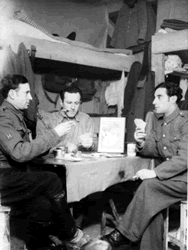
Jewish POWs play cards inside their barracks. Max Beker is pictured on the right.
[Source: Beker, Sonia Pauline, "Symphony on Fire"; New Milford: The Wordsmithy, 2007.]Date: 1941 – 1942 Locale: Goerlitz, [Silesia] Germany
Credit: United States Holocaust Memorial Museum, courtesy of Sonia Beker
Film on Displaced Persons Orchestra to premiere
Vivian Reisman can picture the emotional Friday night get-togethers at her early childhood home in Weehawken as if they were yesterday.
"They always started out so cheerful, with all the music and the singing and eating everything my mother cooked. Everyone brought instruments. It was an impromptu concert," said the Englewood Cliffs resident.
But as the evening wore on, and they sat around the dining room table reflecting on all they had endured, Reisman, the oldest of Henny ( Henia nee Durmashkin) and Simon Gurko's three children, said, "they always ended with the same horrible sobbing."
Reisman recalls eavesdropping on her parents and their Shabbat visitors, Eastern European immigrants who included Reisman's aunt, Fania nee Durmashkin, and uncle, Max Becker. Hidden behind the door of the bedroom she shared with her sister, Rita Lerner, just 13 months her junior, Reisman was riveted by their stories of suffering and loss.
The inconsolable grief of one couple, in particular, haunted Reisman. They, too, had had two daughters. When there was a selection targeting all those who were 10 years old and younger, the couple's older girl, 13, decided to leave her parents behind rather than let her sister die alone.
Lerner, who today lives in Englewood Cliffs, said, of the little she remembers overhearing before she fell asleep, "I had to block it out. It was too painful."
As they grew up, the sisters — and their younger brother, Abe Gurko, of Manhattan —learned more about the devastating history that connected their mother, a vocalist born Henny Durmashkin in 1930, as well as their aunt, a concert pianist, and uncle, a violinist, to a close-knit group of professional musicians.
Liberated by American soldiers following a death march from Dachau in the spring of 1945, the Durmashkin sisters, the only two members of their famed Vilnius musical family to survive the Holocaust, became part of the Displaced Persons Orchestra at St. Otillien. The Bavarian town was the site of the monastery where the refugees were interned from 1945 to 1948.
The group's extraordinary story is the subject of a new documentary, "Creating Harmony: The Displaced Persons Orchestra at St. Otillien," which will have its world premiere at the Museum of Jewish Heritage-A Living Memorial to the Holocaust in New York on Sunday, June 10, at ':30 pm.
Lerner began to cry as she described how the grandmother she never knew, Sonia Durmashkin, was sent to the gas chamber after the family was deported from the Vilna Ghetto to a concentration camp. "My mother and aunt tried to apply makeup to make her look younger, but it didn't work," Lerner said in a telephone interview. Pausing briefly, she added, "This gets so emotional for me."
Lerner continued: Her grandfather, Akiva, the cantor of Vilna's main synagogue and respected composer of liturgical music, had been shot by the SS several years earlier at Ponary, a village on the city's outskirts. Her uncle, her mother's older brother Wolf, who had been a child prodigy and conducted the Vilna Philharmonic, was so brilliant a musician and composer that he was given special dispensation to come and go from the ghetto so that he could entertain audiences that included his Nazi captors. A partisan, he managed to smuggle a piano into the ghetto so that Jewish cultural life could continue. He was shot an hour before liberation, said Lerner, in Klooga, a concentration camp in Estonia.
Lerner's mother, the youngest of the three siblings and in training to be an opera singer before the war, was fluent in eight languages. Years later, after raising her children, Gurko completed the education that was interrupted, earning degrees from the Jewish Theological Seminary and Columbia University. She eventually went to work as a Hebrew school teacher.
Lerner recalled that her mother filled their home with music. "She was never negative or bitter, even though life was hard for them here at first, not knowing the language and without any help. Anything she could possibly sing, in any language, she sang for us."
Although Gurko died in '00' before she could be interviewed for the film, footage of her is included from testimony recorded for the museum's archives. The archives also contain artifacts she donated: posters announcing the orchestra's concerts and photos of herself with conductor and composer Leonard Bernstein.
Others featured in the film, written and produced by John Michalczyk and Ronald A. Marsh, are flutist David Arben, a surviving member of the orchestra who spent his career at the Philadelphia Orchestra, thanks to a scholarship to the Curtis Institute of Music arranged by Bernstein, and the D.P. Orchestra manager, Jascha Gurewitz. A lot of the filming was done at the museum, said Lerner, a board member who was interviewed there for the film, along with her first cousin, Sonia.
How the orchestra, which was first known as the orchestra of survivors and later as the ex-concentration camp orchestra, got started was unclear to Lerner. She said she believed that the musicians connected with each other through word of mouth in the refugee camp. Nor did she know how they acquired instruments or funding for their concerts.
But, said Reisman, their mother often spoke about the fact that "music kept them going after liberation. It helped them to reconnect with what for them represented the normalcy of their lives before the war and gave them great fulfillment to bring music to survivors, helping to restore their faith and leading them down the long road of healing."
It wasn't long before the orchestra gained renown in Europe and abroad for its stirring arrangements of popular Yiddish and Hebrew music, with vocal performances by Henny Durmashkin. Among its fans were two people who would become leaders of the future Jewish state, David Ben-Gurion and Golda Meier.
Bernstein, whose star was rising in the United States, was another. In Munich after the war, Bernstein requested special permission to conduct the musicians. Bernstein managed to join them for three concerts, one in Munich and the other two at Landsberg and Feldafing, two refugee camps that had been sub-camps of Dachau. He accompanied Durmashkin on the piano, but only when she agreed to sing in Hebrew, not Yiddish, she related years later to her children, even though she became known to crowds as "Little Raiseleh," after a Yiddish song she helped make popular. (Lerner speculated that Bernstein's preference for Hebrew stemmed from his Zionism.)
Of the orchestra's experience playing with Bernstein, Reisman said, "My mother said it was incredible, moving. For a brief moment in time, Leonard Bernstein made them feel they could leave behind the hell they had lived through and soar into the magical world of music they loved so much. He left an indelible mark on her soul as well as an amazing legacy."
The orchestra's performance at the Nuremberg Opera House attracted the attention of the international media, in the city to cover the war crimes trials. To highlight Nazi brutality, orchestra members, whose physical scars were still visible, wore the tattered remnants of their concentration camp uniforms on stage.
After Durmashkin left Europe (she met her future husband on the voyage to the United States in 1949), it wasn't until years later, when she was invited to sing Hatikvah and The Star Spangled Banner at the dedication of the Museum of Jewish Heritage, that she performed again in public. Although, Lerner related, "she and her sister did cut an album, 'Songs to Remember,' a collection of Holocaust, Hebrew, and Yiddish music that are still played on Yiddish radio stations in Israel and elsewhere." They also entertained at an annual gathering of ?migr?s from Vilna.
Tickets to the screening of "Creating Harmony," at $10 per person, $7 for students/seniors and $5 for museum members, may be purchased online at http://www.mjhnyc.or
Twenty-five years ago, two sisters Vivian Reisman and Rita Lerner gave birth to first kids at the same time. When they brought home their bundles of joy, they noticed that most of the layette and infant items were made out of synthetic fabrics. This was not acceptable, as they wanted 100% cotton next to their babies’ skin. Hence, they created Baby Steps a cottage industry that they have since nurtured into a steadily, growing kids clothing company.
“We first set out to find the softest 100% cotton that would hold up to our endless washer and dryer tests,” says Vivian. Then they began designing a collection of functional and fashionable infant and toddler basics featuring sophisticated mix and match prints. “The baby boomers were educated consumers and spared no expense for their kids,” continues Ms. Reisman. “We designed things that we loved and also realized that there was a void in the market,” Rita adds. “The timing was right for real moms to impact the kids industry.” With a small investment and the confidence that they were onto something, they launched their first season to a resounding success.
The company is currently experiencing another growth spurt with the addition of Mish Mish, a ready-to-wear collection that the sisters discovered while traveling abroad. The fashion forward collection offers a wide range of styles for boys and girls in sizes infant to teen. “Today’s mothers want their kids to look stylish not trendy,” says Vivian. “Mish Mish is a fresh, new brand that evokes a lifestyle—European styling, great colors, cool details at a reasonable price point.” Vivian and Rita have proven once again that they have their finger on the pulse of what mothers want for their kids. They have tapped into the current market, which is the baby boomers’ babies who are having babies.
Henny Durmashkin (Gurko) 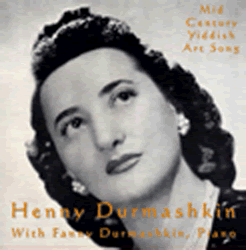
Singer. Born 1924- Died, 2002 in Englewood Cliffs, N.J. Sister of pianist Fanny Durmashkin and conductor Wolf Durmashkin. Henny was the youngest. Her grandfather, Akiva, was the cantor of Vilna’s main synagogue and respected composer of liturgical music. Before the war, Henny had studied opera. She was fluent in 8 languages. Her brother, Wolf Durmashkin, had been prominent in Vilna's cultural, conducting the Vilna Philharmonic, prior to the ghetto life during WWII. In the ghetto, he directed a Hebrew choir and an orchestra in the ghetto. According to Barbara Durmashkin, Wolf perished at the age of 30, on Sept. 19, 1944. He was shot an hour before liberation of the Klooga concentration camp. During its 15 months in existence, the Ghetto orchestra performed 35 chamber and symphonic concerts. The last one took place on Aug. 29, 1943, three and a half weeks before the Ghetto was liquidated. "Liberated by American soldiers following a death march from Dachau in the spring of 1945, the Durmashkin sisters, the only two members of their famed Vilnius musical family to survive the Holocaust, became part of the Displaced Persons Orchestra at St. Otillien. The Bavarian town was the site of the monastery where the refugees were interned from 1945 to 1948." (Jewish Standard--http://www.jstandard.com/articles/2780/1/%91Music-kept-them-going%92) A documentary about the lives of those in the orchestra,"Creating Harmony: The Displaced Persons Orchestra at St. Otillien," had its premiere in summer 2007 at the Museum of Jewish Heritage. Henny met Simon Gurko in 1949, and married him. Henny recorded the album Songs To Remember. She was the mother of Vivian Reisman, Rita Lerner and Abe Gurko. Thursday, Sept. 11, 1997 the Museum of Jewish Heritage -- A Living Memorial to the Holocaust was dedicated. Henny sang the Star Spangled Banner. Henny later donated artifacts to the archives of the Museum of Jewish Heritage including posters from the ghetto orchestra concerts and photos of herself with conductor and composer Leonard Bernstein. She died in the US. Henny Durmashkin's obituary was published in Forward, Aug. 23, 2002 by Alana Newhouse under title, "Henny Gurko, 78, singer who serenaded inmates." (aka Henny Durmashkin) If anyone has more biographical information about this singer, please forward to JMWC. Thanks.
GURKO-Henny Durmashkin. The Trustees and Staff of the Museum of Jewish Heritage A Living Memorial to the Holocaust, mourn the passing of Henny Durmashkin Gurko, beloved mother of our Trustee, Rita Lerner. We extend our heartfelt condolences to Rita and her family. Robert M. Morgenthau, Chairman David G. Marwell, Director.
-----------
The conductor gazed down at the orchestra, waved his baton and the stirring sounds of Grieg's "Triumphal March" began to fill the air. As Max Beker guided the bow over the strings of his violin, Fania Durmashkin's fingers moved expertly across the piano keys. But on May 27, 1945 these accomplished musicians from Vilna, Lithuania, who had contributed so much to the classical and Yiddish musical traditions of their culturally rich city, weren't performing in the rarified atmosphere of the Vilna Concert Hall. Today they were playing the familiar melodies of home, recalling the life they had lived before the world descended into madness, on a makeshift stage erected on the grounds of the St. Ottilien Monastery in Bavaria, Germany.
Seated among the hungry, the sick, and the broken, who had gathered for a concert by survivors for survivors to commemorate their liberation, was Robert Hilliard, a 19-year-old American GI who was stationed on an army base located a few miles from the St. Ottilien Displaced Persons' Camp. As the editor of the base newspaper, he had come to the Liberation Concert in pursuit of an interesting story. Little did he realize on that fateful day, that he would become a vital link in a miraculous chain of events that would ultimately span over 60 years.
Advertisement
Fania Durmashkin Beker
Hilliard described the performance as "A liberation concert at which most of the liberated people were too weak to stand. A liberation concert at which most of the people still could not believe they were free.... A concert of life and a concert of death The movements and faces of the musicians were cramped, tight, fearful as if they momentarily expected guns and clubs to tear apart what, after so many years, must have felt to them like only a dream. When the concert ended many people were crying, few more openly than I."
But Hilliard did more than just cry. Overwhelmed by the misery he had just witnessed he returned to the base determined to correct the abysmal conditions in the DP camp. He enlisted the help of a fellow GI, E. Edward Herman and together, they devised a plan that not only alleviated the suffering of survivors at St. Ottilien but eventually succeeded in changing the U.S. military's policy toward all of the DP camps. The details of their courageous efforts are revealed in Hilliard's memoir, Surviving The Americans: The Continued Struggle of the Jews After Liberation.
Although they had left Germany by the time that I was born in the DP Camp, I finally met these two men who had made such a major impact on the lives of survivors when they reunited with St. Ottilien alumni in the year 2000. Footage of the emotional reunion was included by John Michalczyk, co-director of the Film Studies Program at Boston College, in his award winning documentary, "Displaced: Miracle at St. Ottilien," which was based on Hilliard's book.
It is at this point that the past and the present converge - when paths cross, lives intersect and fate reveals its guiding hand. While Sonia Beker was doing research for a book she was writing to honor the memory of her parents, Max Beker and Fania Durmashkin, the Vilna musicians who met at the St. Ottilien DP camp, she learned of the existence of the documentary. This discovery led her directly to former GI, E. Edward Herman, who immediately recognized the need for a sequel based on the wealth of material in Sonia's newly published book, Symphony on Fire: A Story of Music and Spiritual Resistance During the Holocaust available from Amazon.com.
In her profoundly moving memoir, Sonia Beker chronicles the lives of her parents from their musical beginnings in Vilna, their incarceration in the Vilna ghetto, the concentration, labor and Nazi POW camps, their meeting at the St. Ottilien DP camp and finally, the new life they built together in America. Rich in personal photographs, letters and documents, she paints an intimate and loving portrait of both the Durmashkin and the Beker musical family dynasties against the historical backdrop of the thriving Jewish community of Vilna.
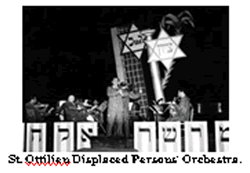
St. Ottilien Displaced Persons' Orchestra.
Sonia writes of her parents: "When the Holocaust destroyed their nurturing, loving families and came close to destroying them as well, music was their passport to survival and transcendence They performed as members of a Jewish orchestra for the Nuremberg tribunal, for David Ben Gurion and Golda Meir, and for DP camp inmates throughout Bavaria. Their reputation was such that, when Leonard Bernstein learned of the remarkable Jewish survivor orchestra who performed in their striped concentration camp uniforms, he was inspired to conduct them." Sonia's aunt, her mother's only surviving relative, Henny Durmashkin, a talented singer who was also a member of the orchestra, was personally accompanied by Bernstein on the piano as she performed songs in Hebrew to honor the newly founded state of Israel.
Symphony on Fire is a valuable addition to the expanding library of books on the Holocaust, detailing both the horror and the heroism. As Sonia Beker notes, "our survivors are slowly leaving us and, just as I'd feared, with their departures, the conscience of the world is dimming. New and bizarre international atrocities and accusations against the Jews fill the news. As a result, there cannot be enough of these memoirs in print or in the electronic media to touch the minds and hearts of everyone who will read and absorb the lessons from the past."
The remarkable story of the St. Ottilien Orchestra, who toured throughout war-torn Europe giving hope and inspiration to survivors like themselves, might have been relegated to a mere footnote in history. But through the efforts of Sonia Beker, Henny Durmashkin's daughter, Rita Lerner, E. Edward Herman, and filmmakers John Michalczyk and Ronald Marsh, the documentary, "Creating Harmony: The Displaced Persons' Orchestra at St. Ottilien" celebrates the resilient, courageous and determined nation that not only rose like a phoenix out of the ashes but learned to play a magnificent new song.
When the documentary had its world premiere in New York on June 10, 2007 at the Museum of Jewish Heritage - A Living Memorial To The Holocaust, the audience was visibly moved by the heroic story of the Jewish musicians who created music that was truly sacred. Each time the members of the St. Ottilien Orchestra reunited with their violins, their clarinets and their cellos they not only healed their wounded bodies and souls but they also reaffirmed the spiritual harmony of creation.
Helen Zegerman Schwimmer
It is so wonderful to recall what a great man Dr Ralph Dourmashkin, my grandfather was, I thought you might like to read this also. He came to the US as an immigrant , I think 1906 at the age of 16,and put himself through medical school while supporting his family and Vera, the daughter of his brother whose father was executed by Stalin. He became "founder of NYU - Bellevue Medical Center". He was extremely accomplished and modified the operating cystoscope and devised a new cystoscope for operative procedures but didn't patent it so that it would be available to everyone. When he was a Captain in the Army medical core in WW I, he was only 21. sons (Dr. Leonard Dourmashkin, my father and Dr.Robert Dourmashkin) both have their name on the large plaque that is in alumni hall at NYU. My brothers Dr Michael Dourmashkin, and Dr Thomas Dourmashkin are also doctors of the hero variety saving lives, and my brother Dr Peter Dourmashkin is an accomplished MIT scientist and professor. My grandfather's great grandson Jordan Dourmashkin is an accomplished Doctor's Assistant at NYU now. I chose a totally different path and have a career as an Director of Animated films, and and Animation Director at Disney for many years. I am also a publisher of two children's books.
I think that the cerebro-spinal meningitis that my grandfather Ralph handled during the war might have been the illness "Encephalitis Lethargica" - a horrible world wide epidemic that followed a sore throat and left the patient in a statue-like condition, speechless and motionless and affected about 5 million patients between 1915 and 1926 - a condition that was extensively studied by his son Dr Robert Dourmashkin.
Grandfather also came up with the idea and name for Faberge perfume, which he suggested to the husband of Vera Dourmashkin. It became a very successful perfume.
Grandfather Ralph was truly a great man, but also in the home movies I have seen had a great sense of humor as well as many friends and married the love of his life Sarah, my grandmother. He held court playing chess for many years in Washington Square Park. I only wish he had lived longer than the age of 65.
My grandfather came to American in 1906 along with my great grandmother and his siblings. would not have been allowed to attend a University in the country he came from but like in the Hamilton musical song :
In New York you can be a new man
In New York you can be a new man
In New York you can be a new man
Here is a biography of myself:
Barbara Dourmashkin was born in New York and now resides in Los Angeles, California with her husband Geoff Case, where they raised two adventurous daughters, Natasha and Sarah.She has written two children's books, one called "Truman's Los Angeles Adventure", where a dog chases a parakeet through fund and interesting places in Los Angeles, and another story about a family dog and her favorite island, where she spent many summers, called Peggy Day’s Martha’s Vineyard Adventure. Barbara has directed, written and produced animated films for Sesame Street,and UNICEF, and has worked for Disney, Warner Bros., Universal and Nickelodeon as an Animation Director. She received her BA from Brandeis University and her MA from UC Berkeley and attended and taught at the San Francisco Art Institute.
thank you Eilat,
Barbara
Barbara Dourmashkin-Case
Barbara.dourmashkin@gmail.com
PAST MEMBERS OF CARAVANS TO AMERICAN
My brother Tom found this obituary about my Grandfather Dr. Ralph Dourmashkin while surfing the internet. As it was so wonderful to recall what a great man Dr Ralph Dourmashkin, my grandfather was, I thought you might like to read this also. He came to the US as an immigrant , I think 1906 at the age of 16,and put himself through medical school while supporting his family and Vera, the daughter of his brother whose father was executing by Stalin. er's great grandson Jordan Dourmashkin is an accomplished Doctor's Assistant at NYU now. And well ...I have my red cross certificate from Disney.
I think that the cerebro-spinal meningitis that my grandfather Ralph handled during the war might have been the illness "Encephalitis Lethargica" - a horrible world wide epidemic that followed a sore throat and left the patient in a statue-like condition, speechless and motionless and affected about 5 million patients between 1915 and 1926 - a condition that was extensively studied by his son Dr Robert Dourmashkin.
Grandfather also came up with the idea and name for Faberge perfume, which he suggested to the husband of Vera Dourmashkin. It became a very successful perfume.
Grandfather Ralph was truly a great man, but also in the home movies I have seen had a great sense of humor as well as many friends and married the love of his life Sarah, my grandmother. He held court playing chess for many years in Washington Square Park. I only wish he had lived longer than the age of 65.
My grandfather came to American in 1906 along with my great grandmother and his siblings. would not have been allowed to attend a University in the country he came from but like in the Hamilton musical song :
In New York you can be a new man
In New York you can be a new man
In New York you can be a new man
Just you wait
Alexander Hamilton
sbeker@aol.com
Mar 11, 2018, 6:05 PM
?Reply
?
to Eilat.gordinlevitan
?
Dear Eilat,
On your web page, http://www.eilatgordinlevitan.com/vilna/vilna_pages/vilna_stories_durmashkin.html, there are great stories about all the members of the Durmashkin and Beker families, except for my mother. Can you please add the following information, which I extracted from my book, "Symphony on Fire: A Story of Music and Spiritual Resistance During the Holocaust," and place it under her picture, which is already very nicely presented on that page? Thank you very much!
The Durmashkin family's home was constantly full of music. Fania Durmashkin's father, Akiva Durmashkin, was a well-known choir director of Vilna's Great Synagogue. He wrote cantorial music and collaborated with Poland's well-known cantors -- Sirota, Rontal and Elphand -- and the great American cantors, Rosenblatt and the Koussevitzky's came to the house to work with him. Her brother, Wolf, and she would often accompany them on the piano as they created cantorial pieces. Singers and violinists often gathered at the house to make music Wolf, whose piano, conducting and composition talents were renowned. People actually gathered in the street outside the house to listen as music was being practiced and performed inside their home.
Fania's passion was the piano, and, like her brother, she studied at the Vilna Conservatory of Music. They had two pianos at home and, and she and her brother both loved to practice, often at overlapping times. So that they wouldn't disturb each other, Wolf would stuff the cracks in the door to try to muffle one another's piano sounds. Fania attended the Yiddish Real Gymnasium as well. She gave piano performances in public. In 1939, the Lithuanian Army came to Vilna, then the Russians took it over. At that time, she performed for the Russian army with her teacher, Professor Kruveh, playing Schumann's concerto for two pianos.
On June 21, 1941, the Nazis marched into Vilna and took it over. The Durmashkin family was eventually herded into the larger of Vilna's two ghettos. As they were marched through the streets to the ghetto, Fania saw a man who had hanged himself from a telephone pole. The man was Dr. Gershuni who committed suicide on Sept. 6, 1941 after stating that this was the punishment given to the Jewish people for not having settled in Israel.
Privation, disease and starvation quickly took over the ghetto population. The Nazis conducted "aktions" where they'd snatch people off the ghetto streets and send them to Ponary, Vilna's killing field, to be shot. The Durmashkins shared a small apartment with five other families. Wolf was the conductor of the Vilna Symphony Orchestra at the time, and the Orchestra members refused to do without him. He received official permission to continue conducting the Orchestra in the symphony hall outside the ghetto, and was taken back and forth for performances under Nazi guard. He asked my mother to write out his music and carry it for him on these occasions, for which she also received special permission, and this gave her a chance to catch further glimpses of the outside world.
In the Vilna ghetto, there were musicians, artists, poets and writers who had been the cream of the city's Jewish cultural community. Wolf Durmashkin formed a 48-member symphony orchestra in the Vilna ghetto. He performed with and conducted them. While on work units outside the ghetto, he managed to find much needed instruments for the musicians, and smuggled them into the ghetto at great personal risk. Wolf also had to find a piano. A work unit of musicians actually found a piano in a deserted house, probably originally a house of Jews who had been executed. They took the piano apart piece by piece, smuggled it back to the ghetto theater and reassembled it there. This was the piano that Fania and others played for performances organized by her brother.
In September 1943, the Vilna ghetto was liquidated. Fania and her sister, Henia, were separated from their beloved family members and taken to Riga, Latvia to a work camp near Kaiserwald, then to Dinawerke, Stutthoff, finally to Kaufering/ Dachau in 1944, then Landsberg, Lager 1. In March 1945, as Germany was being defeated by the Allies, many Dachau inmates, including Fania and Henia, were taken on a death march by their Nazi captors. They were marched without stopping, and if anyone faltered, they were shot. Suddenly, the march was intercepted by American tanks -- the Nazi captors ran away, and the inmates were freed!!
Fania and her sister found themselves in the Landsberg DP camp in the American zone. They became part of an orchestra consisting of Kovno and Vilna musicians. Eventually, Max Beker also joined the DP camp and the orchestra as a violinist. The Ex-Concentration Camp Orchestra performed for other DP camp inmates, the Nuremberg tribunal, Ben-Gurion and Golda Meir, and were conducted for two concerts by Leonard Bernstein, who found them on a cultural mission after inquiring at the Jewish Agency if there was a survivor's orchestra he might contact.
Eventually, Fania and Henia joined Max Beker in Brooklyn, NY in 1950. Henia met her husband-to-be, Simon Gurko, on the ship coming to America. Fania and Max were married in Brooklyn, had a daughter, Sonia, and continued to play music for friends and at survivor gatherings.
Sonia Beker wrote; The Durmashkin family's home was constantly full of music. Fania Durmashkin's father, Akiva Durmashkin, was a well-known choir director of Vilna's Great Synagogue. He wrote cantorial music and collaborated with Poland's well-known cantors -- Sirota, Rontal and Elphand -- and the great American cantors, Rosenblatt and the Koussevitzky's came to the house to work with him. Her brother, Wolf, and she would often accompany them on the piano as they created cantorial pieces. Singers and violinists often gathered at the house to make music Wolf, whose piano, conducting and composition talents were renowned. People actually gathered in the street outside the house to listen as music was being practiced and performed inside their home.
Fania's passion was the piano, and, like her brother, she studied at the Vilna Conservatory of Music. They had two pianos at home and, and she and her brother both loved to practice, often at overlapping times. So that they wouldn't disturb each other, Wolf would stuff the cracks in the door to try to muffle one another's piano sounds. Fania attended the Yiddish Real Gymnasium as well. She gave piano performances in public. In 1939, the Lithuanian Army came to Vilna, then the Russians took it over. At that time, she performed for the Russian army with her teacher, Professor Kruveh, playing Schumann's concerto for two pianos.
On June 21, 1941, the Nazis marched into Vilna and took it over. The Durmashkin family was eventually herded into the larger of Vilna's two ghettos. As they were marched through the streets to the ghetto, Fania saw a man who had hanged himself from a telephone pole. The man was Dr. Gershuni who committed suicide on Sept. 6, 1941 after stating that this was the punishment given to the Jewish people for not having settled in Israel.
Privation, disease and starvation quickly took over the ghetto population. The Nazis conducted "aktions" where they'd snatch people off the ghetto streets and send them to Ponary, Vilna's killing field, to be shot. The Durmashkins shared a small apartment with five other families. Wolf was the conductor of the Vilna Symphony Orchestra at the time, and the Orchestra members refused to do without him. He received official permission to continue conducting the Orchestra in the symphony hall outside the ghetto, and was taken back and forth for performances under Nazi guard. He asked my mother to write out his music and carry it for him on these occasions, for which she also received special permission, and this gave her a chance to catch further glimpses of the outside world.
In the Vilna ghetto, there were musicians, artists, poets and writers who had been the cream of the city's Jewish cultural community. Wolf Durmashkin formed a 48-member symphony orchestra in the Vilna ghetto. He performed with and conducted them. While on work units outside the ghetto, he managed to find much needed instruments for the musicians, and smuggled them into the ghetto at great personal risk. Wolf also had to find a piano. A work unit of musicians actually found a piano in a deserted house, probably originally a house of Jews who had been executed. They took the piano apart piece by piece, smuggled it back to the ghetto theater and reassembled it there. This was the piano that Fania and others played for performances organized by her brother.
In September 1943, the Vilna ghetto was liquidated. Fania and her sister, Henia, were separated from their beloved family members and taken to Riga, Latvia to a work camp near Kaiserwald, then to Dinawerke, Stutthoff, finally to Kaufering/ Dachau in 1944, then Landsberg, Lager 1. In March 1945, as Germany was being defeated by the Allies, many Dachau inmates, including Fania and Henia, were taken on a death march by their Nazi captors. They were marched without stopping, and if anyone faltered, they were shot. Suddenly, the march was intercepted by American tanks -- the Nazi captors ran away, and the inmates were freed!!
Fania and her sister found themselves in the Landsberg DP camp in the American zone. They became part of an orchestra consisting of Kovno and Vilna musicians. Eventually, Max Beker also joined the DP camp and the orchestra as a violinist. The Ex-Concentration Camp Orchestra performed for other DP camp inmates, the Nuremberg tribunal, Ben-Gurion and Golda Meir, and were conducted for two concerts by Leonard Bernstein, who found them on a cultural mission after inquiring at the Jewish Agency if there was a survivor's orchestra he might contact.
Eventually, Fania and Henia joined Max Beker in Brooklyn, NY in 1950. Henia met her husband-to-be, Simon Gurko, on the ship coming to America. Fania and Max were married in Brooklyn, had a daughter, Sonia, and continued to play music for friends and at survivor gatherings.
Barbara Dourmashkin-Case is with Natasha Case and 11 others.
February 5
My brother Tom found this obituary about my Grandfather Dr. Ralph Dourmashkin while surfing the internet. As it was so wonderful to recall what a great man D...
See More
8 Comments
22
Leticia Lichtwardt, Sherie Pollack and 20 others
LikeShow more reactions
CommentShare
Comments
View 4 more comments
Denise Tandlich Lasky so amazing to read the history of your father's side of the family. Wonderful that you've been able to learn all of that!
1
Manage
LikeShow more reactions · Reply · 8h
Barbara Dourmashkin-Case I am grateful my Great Grandmother got out of there. The story was she went to the Czar and demanded a pension when her husband died. She used that money to come to America on one of the CARAVAN boats that left from Hamburg.
Manage
LikeShow more reactions · Reply · 6h
Barbara Dourmashkin-Case My grandfather Ralph came to American in 1906 along with my great grandmother and his siblings. He would not have been allowed to attend a University in Russica, the country he came from but like in the Hamilton musical song :
In New York you can be a new man
In New York you can be a new man…See More
1
Manage
LikeShow more reactions · Reply · 6h · Edited
Leticia Lichtwardt Beautiful story
Manage
LikeShow more reactions
· Reply · 2harbara Dourmashkin-Case 3852 Camino de Solana
C 818 421 2367 Sherman Oaks, Ca 91423
Barbara.dourmashkin@gmail.com
